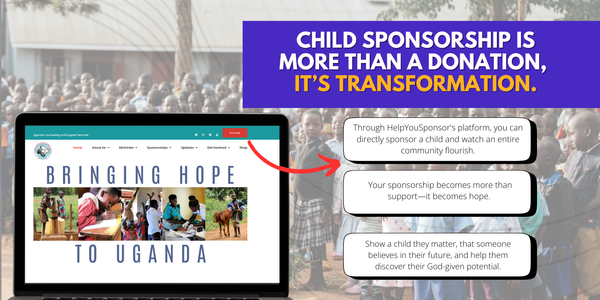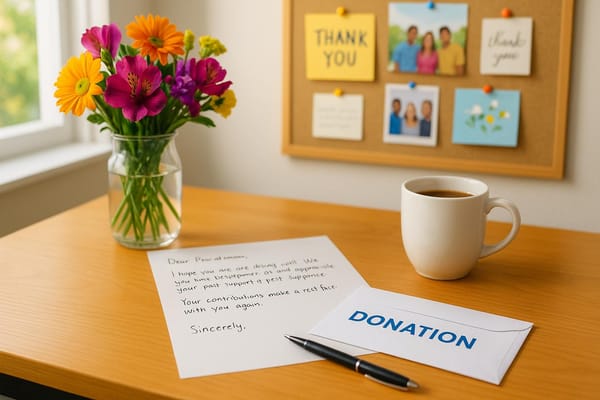How to Use Stories to Connect with Donors
Learn how to harness the power of storytelling to emotionally connect with donors and boost fundraising efforts for your nonprofit.

Stories are powerful tools for nonprofits. They create emotional connections, inspire action, and help donors see the tangible impact of their contributions. Unlike plain data, stories make causes relatable and memorable - people are 22x more likely to remember facts when presented in a story. Nonprofits that prioritize storytelling see better results, including up to 50% more donations and higher donor retention rates.
Key takeaways for using stories effectively:
- Engage emotions first, then add data: Stories build connection; data builds trust.
- Focus on transformation: Highlight "before-and-after" journeys to show impact.
- Make donors the heroes: Emphasize how their contributions drive change.
- Use the right format and platform: Videos, visuals, and written stories work differently across platforms like Instagram, Facebook, and email.
- Measure and refine: Track metrics like donor retention, social media engagement, and donation amounts to improve storytelling.
Craft Better Impact Stories For Donors With These Tips
Why Stories Work: Emotional Impact and Donor Psychology
Stories have a unique power to connect with donors on a deeper level, shaping how they perceive and process information. When you share a heartfelt story about someone your organization has helped, it creates a neurological experience that strengthens the donor's connection to your cause.
Stories engage multiple areas of the brain at once, turning passive listeners into active participants. Dr. Uri Hasson explains it best: “By simply telling a story, (a person) could plant ideas, thoughts, and emotions into the listener’s brains. A story is the only way to activate parts in the brain so that a listener turns the story into their own idea and experience”. This kind of brain engagement directly impacts donor behavior. Nonprofits that prioritize storytelling see a donor retention rate of 45%, compared to just 27% for organizations that don’t focus on stories. Personal connection plays a key role - 75% of people need to feel strongly about a cause before donating, and 61% say their own life experiences heavily influence their giving decisions.
"Human behavior is the driving force behind the act of giving, and a complex combination of motivations and influences. From the profound impact of empathy to the compelling force of personal connection, grasping these intricacies becomes the key to understanding why people choose to open their hearts and donate." - Samantha Ste Marie, Marketing Specialist at Givecloud
This emotional and neurological engagement lays the foundation for understanding the science behind storytelling in fundraising.
The Science Behind Storytelling in Fundraising
The impact of storytelling in fundraising isn’t just an opinion - it’s backed by research showing that emotionally resonant campaigns inspire more generosity. Fundraising campaigns rooted in storytelling see a 50% increase in donations compared to those centered on data alone. Why? Because stories evoke emotional responses that raw numbers simply can’t.
Giving is more emotional than logical. While donors may believe they’re making rational decisions based on facts, neuroscience shows that emotions are the primary driver of giving. The "identifiable victim effect" illustrates this perfectly: donors are far more likely to connect with individual stories than with broad statistics. By personalizing your nonprofit’s narrative, you can amplify this effect.
Different emotions within stories spark different actions. Hope fosters long-term commitment, empathy builds immediate bonds, and urgency drives quick responses. Real-world examples highlight this. One nonprofit increased donor contributions by 47% in a year by sharing stories of seniors who gained independence through housing and food programs, combining personal narratives with data on reduced hospitalizations. Another organization saw a 65% spike in emergency donations by sending appeals with urgent subject lines like "Maria's pantry is empty - can you fill it by midnight?" followed by impact updates featuring photos.
Since 63% of people remember narrative details better than isolated statistics, campaigns driven by stories create lasting impressions and stronger donor relationships.
Stories vs. Data: Finding the Right Balance
To truly resonate with donors, it’s not about choosing between stories and data - it’s about knowing how to combine them effectively. Stories make abstract numbers relatable, while data builds credibility and trust.
Start with emotion, then add evidence. Research shows that story-based brochures generate donations of $2.38 per participant, compared to $1.14 for materials focused solely on infographics. However, the most impactful campaigns strategically blend both elements.
Timing is everything. Begin with a story to capture attention and create an emotional connection, then follow up with data to reinforce trust and credibility. This approach mirrors how donors process information - they need to care first, then see proof before they commit.
Different donor groups respond to varying balances of stories and data. Major donors often want detailed metrics paired with compelling narratives, while grassroots supporters might connect more with story-heavy appeals that use minimal statistics. Tailoring your approach based on your audience ensures greater success.
Visual storytelling helps bridge the gap. Infographics that combine personal photos with key data points or videos that weave individual stories into program outcomes create layered, engaging experiences that appeal to both the heart and the mind.
The goal isn’t a perfect 50/50 split - it’s about thoughtful integration. For example, your annual report might lean heavily on data with a few story highlights, while your social media posts could focus on narratives with supporting stats woven in naturally. Transparency is crucial, too. Sharing both successes and challenges through stories, backed by honest data about costs and outcomes, builds the trust that today’s donors expect.
How to Create Stories That Connect with Donors
Crafting stories that genuinely connect with donors involves being real, ethical, and thoughtful. At its core, it’s about uncovering authentic voices from your community and presenting them in a way that builds trust and emotional connection.
Finding and Collecting Powerful Stories
Start by gathering stories from the people closest to your mission - beneficiaries, volunteers, donors, board members, and others in your community. These voices carry far more weight than polished marketing materials.
Before sharing any story, always get written permission. Let individuals decide how their story will be used. This not only respects their dignity but also strengthens trust between your organization and those you serve.
To keep the flow of stories steady, make story collection part of your regular operations. Use tools like story submission forms, newsletters, or direct outreach. You can also be proactive - reach out to beneficiaries, donors, and volunteers through surveys, interviews, or casual conversations. Encourage them to share specific details about their experiences and the impact your organization has had.
For example, the Meals on Wheels Foundation of Northern Illinois created a direct mail appeal featuring a beneficiary named Ruthie. Her photo and story added a personal touch that resonated with donors. Similarly, We Raise Foundation highlights volunteer stories on their website, using photos, quotes, and detailed narratives from participants.
When collecting stories, focus on transformation and vivid details. Stories that show a clear before-and-after journey resonate most. Donors connect with specific, relatable examples that bring your impact to life.
Once you’ve gathered these narratives, organize them using proven storytelling frameworks.
Story Frameworks for Nonprofits
Using a structured framework can make your stories more compelling while boosting credibility with donors. Here are a few options:
| Storytelling Framework | Description |
|---|---|
| Before-After-Impact | Share what life was like before your intervention, the work you did, and the results achieved. |
| Challenge-Solution-Result | Outline a challenge, explain your solution, and describe the measurable outcome. |
| Data-Story-Call to Action | Combine data with a personal story, ending with a clear call to action. |
| Problem-Intervention-Outcome | Highlight the problem, your intervention, the outcome, and what comes next. |
Plan your storytelling roadmap early in your campaign. This ensures consistency across platforms and keeps your message unified. Blending individual stories with broader organizational impact is also key. For example, show tangible results alongside personal testimonials to meet donors’ desire for emotional connection and evidence of effectiveness.
Some organizations excel at this balance. Girls Code Initiative uses data-driven storytelling to showcase how their programs empower young girls. Similarly, Talent Beyond Boundaries integrates real-time dashboards with Salesforce to provide live updates on outcomes, fostering transparency and trust with funders.
Research shows that organizations that share compelling stories can raise up to 400% more in donations compared to those that rely solely on facts. So, while data is important, keep the human element front and center.
Once your framework is in place, shift your focus to making donors the heroes of your story.
Making Donors the Heroes of Your Story
A great story doesn’t just showcase your impact - it makes your donors feel like the driving force behind it. Today’s donors want to see how their contributions are making a difference and be part of something bigger than themselves.
Position donors as the solution. Highlight how their support enables your work, rather than focusing solely on your organization’s efforts. This approach builds stronger, lasting relationships rather than just one-time gifts.
Organizations like Miriam’s House excel at this. Their messaging, “You can help end the cycle of homelessness,” directly positions donors as heroes. Raising Hope Dogs uses the phrase “Give A Gift, Change A Life” to emphasize donor impact, while Volo Kids frames their supporters as the ones driving real change.
Encourage donors to get involved beyond giving. Invite them to volunteer, advocate, or participate in peer-to-peer fundraising. Recognize their contributions regularly to reinforce their importance and inspire continued support. You can even invite donors to share their own stories. This not only creates authentic content but also strengthens their connection to your mission.
However, while making donors the heroes, it’s essential to maintain the dignity and agency of your beneficiaries. The goal is to create a partnership, not a savior narrative. Always consider how everyone involved will feel when they see the final story.
Choosing the Right Platforms and Formats for Stories
Once you've crafted compelling stories, the next step is figuring out where and how to share them for maximum impact. Picking the right formats and platforms can make all the difference in connecting with your audience and driving engagement.
Comparing Story Formats: Written, Visual, and Video
Different formats resonate with audiences in unique ways. The choice depends on your message, your audience, and the resources at your disposal.
- Written stories are ideal for sharing detailed information or complex narratives. They let readers engage at their own pace, making them perfect for email newsletters, blog posts, and annual reports. Plus, they boost search engine visibility, helping new donors find your organization.
- Visual stories grab attention quickly and simplify complex ideas. For example, social media posts with images see 650% more engagement than text-only posts. Photos, infographics, and illustrations are highly shareable and work well on platforms like Instagram or as website banners.
- Video stories deliver a powerful emotional punch by combining visuals and sound. Viewers retain 95% of a video's message compared to just 10% of written text. Videos are great for showcasing real people and demonstrating your organization's impact in action.
Here's a quick comparison of these formats:
| Format | Best Use Cases | Strengths | Limitations |
|---|---|---|---|
| Written | Email campaigns, blogs, case studies | Detailed storytelling, SEO benefits | Requires strong writing skills, lower engagement rates |
| Visual | Social media, infographics, banners | Quick impact, highly shareable | Limited depth, needs design expertise |
| Video | Fundraising, testimonials, websites | Emotional connection, high retention | Higher production costs, needs video skills |
"A story told by visuals pulls at the heartstrings in a big way." – Carly Euler, Marketing Manager, MemoryFox
Choosing the right format is only half the battle. You also need to match it to the most effective platform for your audience.
Best Platforms for Sharing Stories
Every social media platform has its strengths, and tailoring your content to each one can amplify your reach.
- Facebook is great for community engagement and fundraising. Use tools like Facebook Fundraisers to turn stories into donation opportunities or go live to share updates in real time. Creating groups around specific causes can help deepen supporter connections.
- Instagram excels at visual storytelling, especially for younger audiences. Charity: Water, for instance, uses vibrant images, Stories, and videos to highlight their clean water initiatives. Features like the "Donate" sticker make it easy to turn engagement into action.
- LinkedIn connects you with professionals and corporate donors. Share impact stories alongside thought leadership content, and use targeted ads to reach decision-makers who might sponsor your programs.
- YouTube is the go-to for long-form storytelling. Use it to post success stories, behind-the-scenes footage, or detailed program explanations. Partnering with YouTube creators can help you tap into their loyal audiences.
- Email campaigns remain one of the most effective ways to tell nonprofit stories. They allow for longer narratives and direct calls to action. And don’t overlook text messaging - nonprofit revenue from text messages grew by 14% between 2022 and 2023.
Organizations like Feeding America show how to adapt stories for different platforms. They combine impactful statistics about food insecurity with family success stories and actionable donation links, tailoring their message to each platform's strengths.
The most successful nonprofits create a storytelling ecosystem where platforms work together to guide supporters from awareness to action. Once you’ve selected your platforms, integrating them with donor management tools can help you maintain consistency and personalization.
Using HelpYouSponsor for Story Integration

Managing stories across multiple channels can feel overwhelming. That’s where HelpYouSponsor comes in. This platform helps you centralize and streamline your storytelling efforts, making it easier to connect with donors on a personal level.
- Integrated messaging: Share personalized updates and impact stories directly with donors. Automated communications keep supporters engaged without requiring manual effort. This personal touch matters - organizations using strong stories retain 45% of donors, compared to just 27% for those that don’t.
- Automated workflows: HelpYouSponsor ensures your stories reach the right people at the right time. For instance, when a donor sponsors a child’s education, the platform can automatically send updates about that child’s progress, creating a direct link between the donor’s contributions and their impact.
- Reporting tools: Track which stories resonate most with your audience. See what generates the highest engagement, leads to donations, and works best for different donor segments. This data helps you fine-tune your storytelling over time.
- Donation pages: Connect stories directly to giving opportunities. When donors read about a need or success story, they can donate immediately without leaving the platform. This seamless process makes it easier to act on the emotional connection your story creates.
HelpYouSponsor users have collectively managed over $19 million in donations and increased sponsorships by an average of 3.8x. The platform’s ability to integrate storytelling with donor management has been key to these results.
It also works with tools like Mailchimp and Zapier, allowing you to incorporate HelpYouSponsor stories into your broader marketing strategy. This ensures your storytelling remains cohesive across all channels, building stronger relationships with your supporters over time.
Tracking and Improving Your Storytelling Results
Creating engaging stories is just the first step. Nonprofits need to consistently test, analyze, and refine their storytelling efforts to ensure they continue to connect with donors. Tracking the right metrics can help you determine if your narratives are making an impact.
Key Metrics to Measure Storytelling Success
To understand which stories inspire action, focus on these key performance indicators:
- Donor Retention Rate: Measure how many donors continue contributing year after year. This shows how well your stories are building long-term engagement and satisfaction. Analyze this annually and segment by donor type to see which narratives resonate with different groups.
- Social Media Engagement: Look at likes, shares, comments, and follows to see how your message is landing. Instead of just focusing on overall numbers, compare engagement rates relative to your follower count and evaluate how different types of stories perform.
- Website Traffic and Conversion Rates: Tools like Google Analytics can reveal how visitors interact with your storytelling pages. Track metrics like time spent on these pages and the percentage of visitors who take action, such as donating or signing up, to identify the most effective stories.
- Email Performance Metrics: Monitor open rates and click-through rates to assess how well your stories capture attention. A strong subject line paired with compelling content can drive readers to donation pages.
- Event Conversion Rates: Calculate how many event attendees become donors or increase their giving after hearing your stories. This is particularly useful for events like galas or community presentations where storytelling plays a central role.
- Average Donation Amounts: Storytelling can significantly impact giving. For instance, combining impactful narratives with strategies like matching gifts has been shown to increase response rates by 71% and average gift amounts by 51%. Compare donation levels before and after story-driven campaigns to measure success.
Using Data to Improve Your Stories
Blending storytelling with data allows nonprofits to communicate their impact more effectively. Focus on collecting data that aligns with what matters to your donors. For example, if education is a priority, track outcomes such as graduation rates.
Transform complex data into visuals like infographics or interactive maps to make it easier for supporters to understand and remember. A great example is the World Wildlife Fund's 2023 Annual Report, which used data to highlight conservation efforts in Namibia and rhino poaching prevention.
Establishing an Impact Framework can help tie individual stories to your organization’s broader mission. This approach allows you to demonstrate how your work delivers results, making your stories more compelling and inspiring for donors.
Feedback from donors can also guide your storytelling. Use surveys to ask questions like, "Which stories made you feel most connected to our mission?" or "What would help you better understand our impact?" This input can help you refine your narratives.
Experiment with different formats - written, visual, or video - and analyze which ones resonate most. Share your stories across multiple platforms, including social media, email campaigns, and detailed impact pages. This multiplatform approach ensures your message reaches a wider audience and deepens engagement.
Case Study: Measuring Impact with HelpYouSponsor
Data isn’t just a tool for analysis - it’s a way to transform your storytelling. HelpYouSponsor provides a real-world example of how nonprofits can use analytics to improve donor engagement.
HelpYouSponsor’s integrated tools allow organizations to track key metrics like donor retention, website visits, and social media interactions in real time. With automated messaging and centralized performance dashboards, nonprofits can deliver personalized story updates that strengthen connections with supporters.
Conclusion: Building Stronger Donor Connections Through Stories
Stories have the power to transform abstract causes into relatable, emotional experiences that resonate deeply with donors. When nonprofits embrace storytelling, they create bonds that extend far beyond simple financial transactions. The numbers back this up: nonprofits that effectively use compelling narratives can raise up to 400% more in donations compared to those that rely solely on facts and figures.
At the heart of impactful storytelling lies authenticity and transparency. Duke Haddad from The Salvation Army Indiana Division puts it best: "Authenticity and transparency build trust - the key to obtaining first donations and eventual larger donations". Trust is the cornerstone of donor relationships, and emotionally connected donors are 52% more valuable than those with standard connections.
Why are stories so effective? Because they stick. Research shows that stories are remembered up to 22 times more than plain facts and increase neural engagement fivefold. By sharing real stories about real people and real impact, you ensure your message lingers in the minds of your audience long after they've read an email or watched a video.
Choosing the right platform is just as important as crafting the story itself. Social media posts featuring stories can generate up to 10 times more engagement than those without. Whether through videos, written content, or visuals, tailoring your storytelling format to match your donors' preferred platforms ensures your message reaches them in the most effective way.
But storytelling is not a one-and-done effort - it’s an ongoing process. The best nonprofits continuously refine their storytelling strategies by collecting fresh stories, experimenting with different approaches, and analyzing what resonates. Those that prioritize storytelling see a 45% donor retention rate, compared to just 27% for organizations that don’t.
When you position donors as the heroes of your stories and highlight the tangible impact of their contributions, you’re doing more than fundraising - you’re inviting them into a meaningful partnership. This approach not only boosts donations but also strengthens the emotional connection between donors and your mission.
Storytelling also fosters dialogue, not just one-way communication. Nonprofits that encourage supporters to share their own experiences build stronger, more active communities. With 80% of donors more likely to support organizations that share stories about causes they care deeply about, investing in storytelling pays off in both engagement and long-term loyalty. By consistently sharing genuine, impactful stories, your nonprofit can turn donations into lasting partnerships that drive your mission forward.
FAQs
How can nonprofits use storytelling and data together to engage donors effectively?
Nonprofits have a unique opportunity to connect with donors by combining emotional storytelling with compelling data. While stories tap into empathy and inspire action, data reinforces the message by showing tangible results. For instance, sharing the journey of someone positively impacted by your organization, paired with statistics that highlight the broader success, can create a lasting impression.
To make these connections even stronger, tailor your stories and data to resonate with specific donor groups. By leveraging insights like donor preferences or past contributions, you can craft messages that feel personal and impactful. This thoughtful mix of emotion and evidence not only builds trust but also encourages donors to invest in your mission.
What ethical guidelines should nonprofits follow when collecting and sharing stories from donors and beneficiaries?
When telling stories, it's crucial to uphold ethics and respect at every step. Always make sure to get informed consent from donors and beneficiaries, ensuring they clearly understand how their stories will be shared. Protect their privacy and honor their comfort by steering clear of any kind of manipulation or exploitation.
Be upfront about why the story is being shared and who the audience will be. Whenever possible, give individuals the chance to review and approve their stories before they go public. This not only builds trust but also preserves their dignity and deepens the bond between your organization and its supporters.
What are the best storytelling formats and platforms to connect with different types of donors?
To engage with a variety of donor groups, storytelling formats like written narratives, short videos, and interactive digital content are highly effective. These methods help build emotional connections by highlighting tangible impacts and creating a sense of involvement.
When it comes to platforms, social media is perfect for reaching a wide audience, while email campaigns and nonprofit websites provide opportunities for more personalized storytelling. Additionally, nonprofit-specific tools, such as donor management platforms, enable you to tailor your stories to align with donor preferences, ensuring your message resonates with different groups.
By pairing compelling storytelling formats with the right platforms, you can inspire donors and strengthen their connection to your cause.





